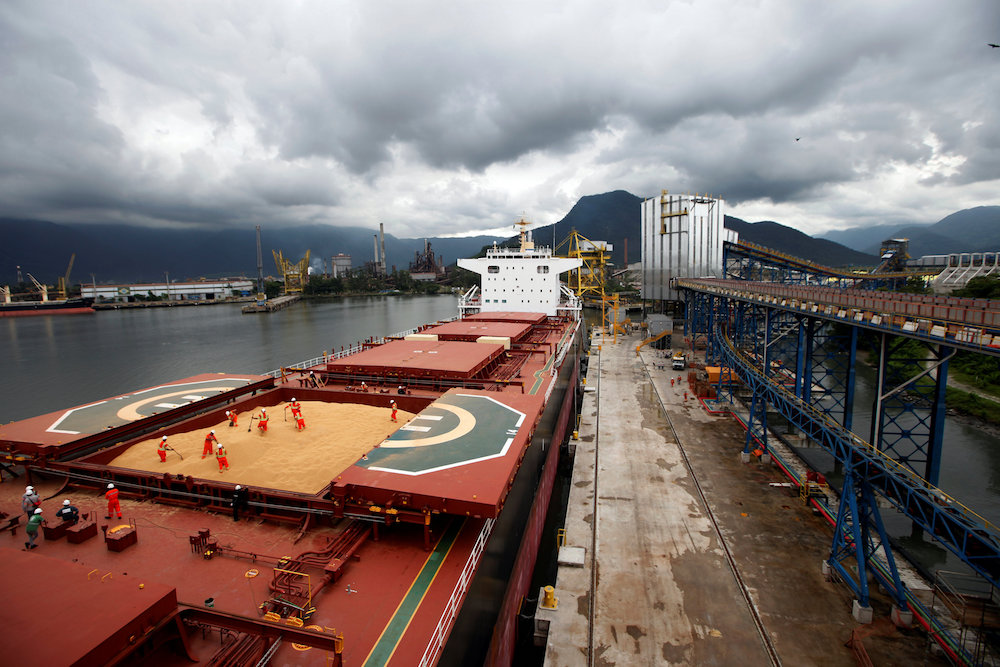Soy and sugar traders are fighting for room in Latin America’s largest port, rushing to secure loading slots as the slowest Brazilian soy harvest in 10 years pushes the grains export window into the sugar season.
Congestion was hitting Brazil’s Santos port just as consumers worldwide have been turning to top exporter Brazil for sugar and soybean supplies. The glut of shipments waiting to leave is boosting transport costs and will likely delay arrivals at destinations.
Sugar prices hit a four-year high late last month, boosted by supply tightness. Soybean prices, already near seven-year highs, could rise further at a time when Brazil is effectively the world’s main supplier.
“It is a perfect storm, a combination of factors that are leading to soy and sugar to compete for logistics,” said Tiago Medeiros, Brazil head and executive director for Czarnikow Group, a food trader and supply chain services provider.
Brazil usually starts soybean exports in January, with volumes increasing in later months. This season, planting was delayed, as was the harvest, pushing that window further out. Shipments from the new sugar crop usually start around April, but companies are still shipping stocks from a bumper crop in 2020.
Brazil’s Agriculture Ministry saw sugar stocks at 7.3 million tonnes in mid-February, the highest for the last three years. Market players expect growing delays in coming months, with ships likely waiting several weeks before being able to dock in Santos. Medeiros noted that spot prices for both sugar and soybean futures are higher than deferred ones. This inverted chart position signals near-term supply tightness, he said, which could mean financial losses for sellers if they fail to deliver on time. “So everyone wants to get products out as soon as possible,” he said.
Most crops in Brazil are moved by truck, so truck freight costs spiked due to the rush of goods. Traders said shipowners sharply raised demurrage, the daily fee charged for port delays, from around $18,000 per day to $30,000 per day on trips to Brazil. Because of long vessel waiting times, French trader Sucden said India might be an alternate sugar supplier, but traders said its supply is constrained for several reasons. “Brazil mainly exports raws, while India has surplus of whites. So direct substitution is limited,” said a source at a large sugar trader in India.
Chinese soy buyers would normally turn to the United States to avoid Brazilian congestion, but U.S. farmers have little to offer. Due to strong demand, the United States will only have about 10 days worth of soybean supplies before the U.S. harvest starts in September. The U.S. Department of Agriculture forecast soybean stocks at the Aug. 31 end of the 2020/21 marketing year at 120 million bushels, down sharply from 525 million a year earlier. It would be the smallest ending stocks since 2013/14.
By mid-March, vessels were expected to load nearly 8.82 million tonnes of soybeans in Santos and Paranagua, the two largest Brazilian ports, 27% more than at this time last year, according to data from SA Commodities/Unimar shipping agency. Sugar loading at both ports was seen 71% up at 1.27 million tonnes. Traders controlling terminals in Santos such as Bunge and COFCO and logistics operators usually turn berths from grains to sugar as the year progresses. That job will be harder this year, the sources said. Last year, some vessels in Brazil waited as long as 45 days to load sugar at the key sugar terminal operated by Rumo SA.
“It will likely be worse,” said a U.S.-based sugar broker.
Copyright Ships & Ports Ltd. Permission to use quotations from this article is granted subject to appropriate credit given to www.shipsandports.com.ng as the source.

